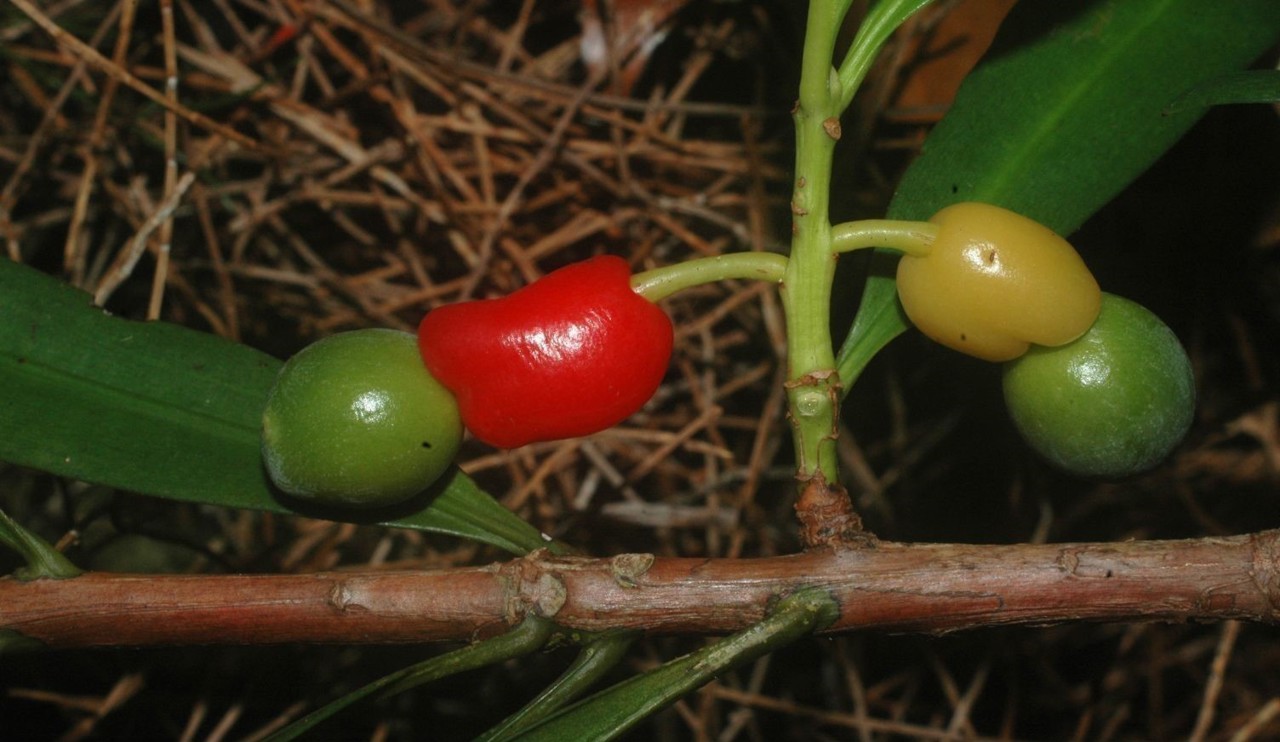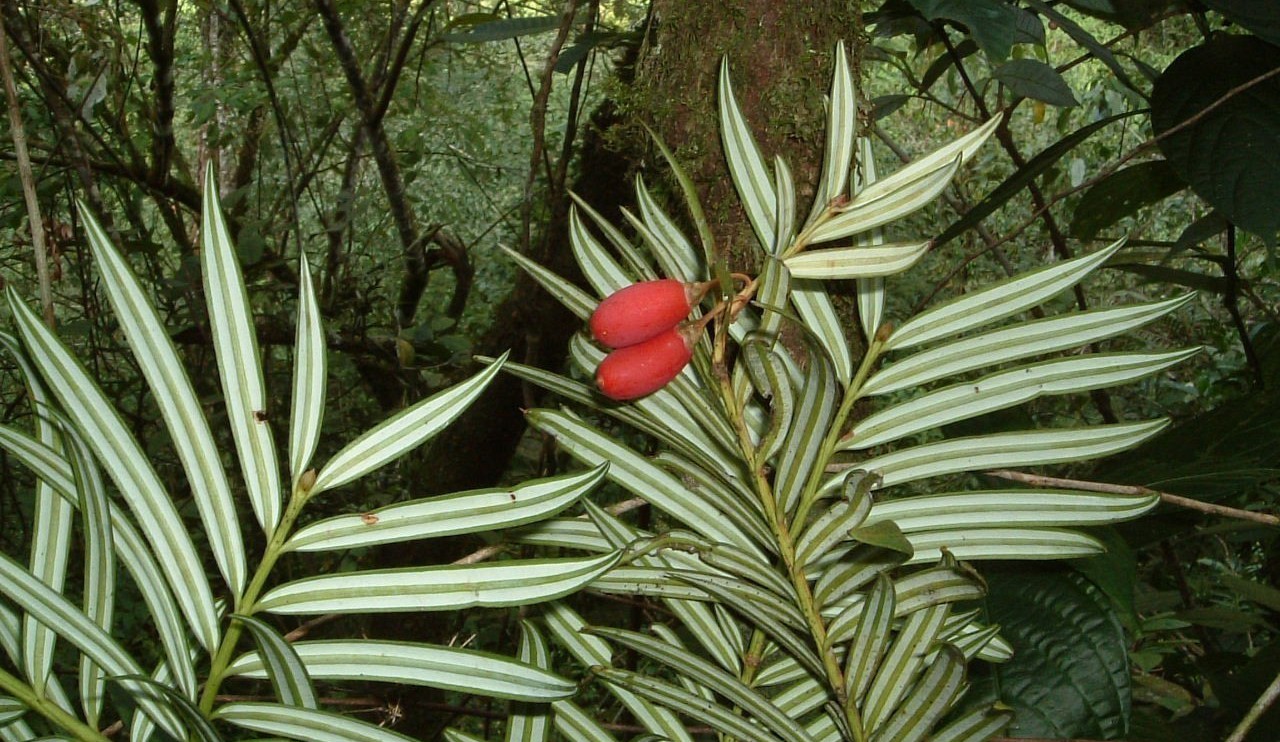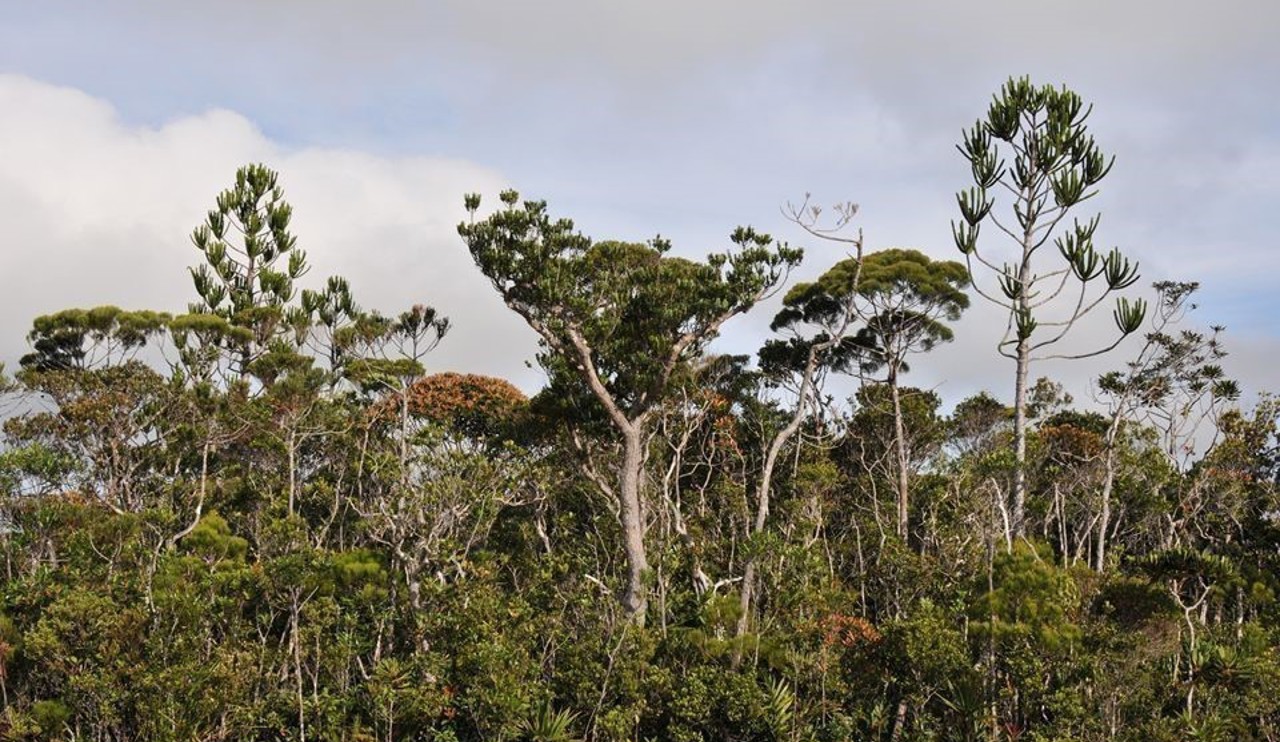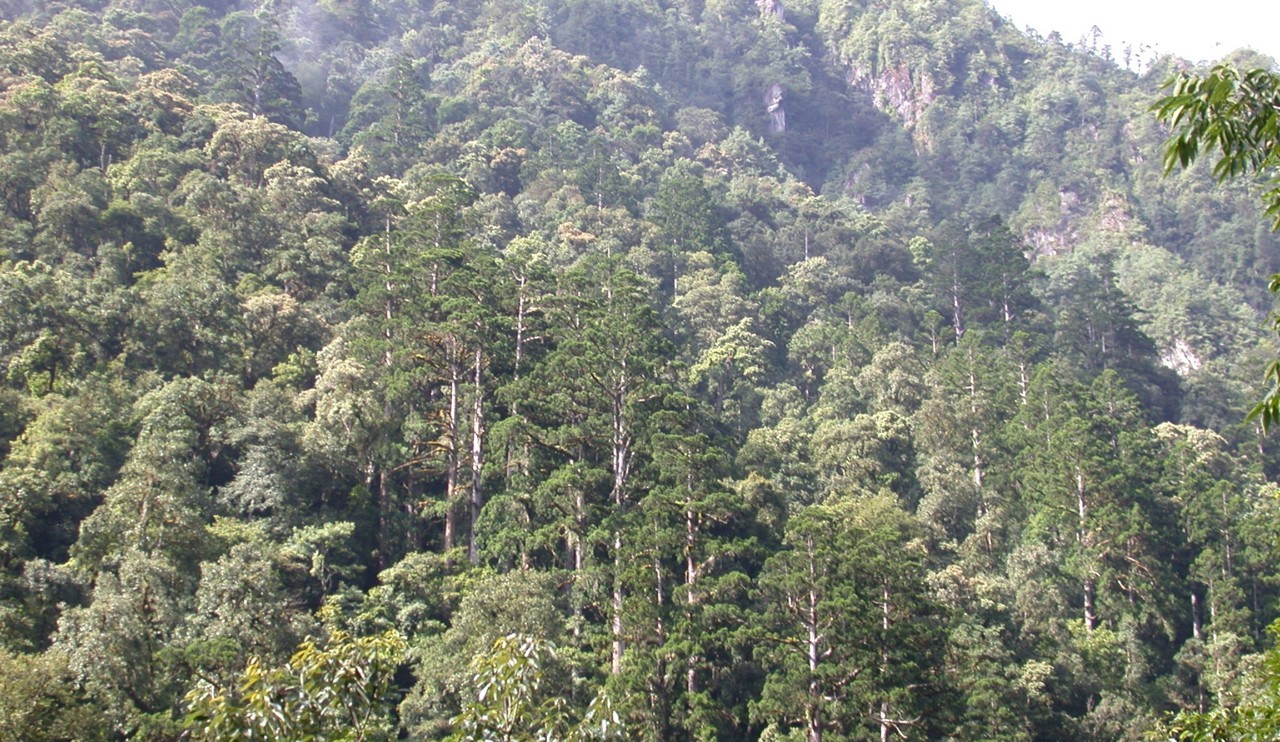Overview
- Podocarpaceae
- Taxaceae
- Araucaria
We focus on three important families of conifers where many species are poorly known. We use a combination of traditional alpha taxonomic methods and molecular techniques to revise known species, identify new taxa and investigate evolutionary relationships and processes.
Podocarpaceae
This family is one of the two principal Southern Hemisphere conifer families (the other is the Araucariaceae). It contains 19 extant genera and 174 species recognised by the IUCN. Species occur in all the Southern Hemisphere continents; some cross the equator into the Caribbean Islands and Central America, NE Africa, SE Asia and Japan. Many species are more or less narrowly endemic; 54 are listed in the 2017 IUCN Red List. Most are dispersed by vertebrates, especially birds; many of the dispersal agents are also threatened. One species, Parasitaxus usta, is the world's only ‘parasitic' gymnosperm. Its host is another member of Podocarpaceae, Falcatifolium taxoides; both grow only on New Caledonia. Current research focuses on revising the genus Podocarpus which currently has over 100 species.

Female cones of Podocarpus orarius RR Mill & Whiting, a recently described species from the Solomon Islands
Key publications
Mill RR (2016) A monographic revision of Retrophyllum (Podocarpaceae) Edinburgh Journal of Botany. 73(2):171-261
Mill RR (2015) A monographic revision of the genus Podocarpus (Podocarpaceae): III. The species of the Central America and Northern Mexico Bioregion Edinburgh Journal of Botany 72(2): 243-341
Mill RR (2015) A monographic revision of the genus Podocarpus (Podocarpaceae): II. The species of the Caribbean Bioregion Edinburgh Journal of Botany 72(1): 61-185
Mill RR (2014) A monographic revision of the genus Podocarpus (Podocarpaceae): I. Historical Review. Edinburgh Journal of Botany 71(3): 309-360
Mill RR and Whiting, M. (2012) Podocarpus orarius (Podocarpaceae), a new species from the Solomon Islands and a taxonomic clarification of Podocarpus spathoides from Malaysia. Gard. Bull. Singapore 64 (2) 171-193
Main Contact: Dr Robert Mill.
Taxaceae
A small predominantly northern hemisphere family with five genera. Taxus is the most widespread, morphologically variable and over-exploited. Our work involves collaborating with other researchers in China, Nepal, Pakistan, Vietnam and Lao PDR, with the research mainly focussed on species delimitation and biogeography of Taxus and Amentotaxus in the Himalayas and China.

Amentotaxus yunnanensis photographed in-situ in northern Vietnam
Key publications
Gao LM, Yan L, Phan LK, Yan LJ, Thomas P, Phan L, M Möller and DZ Li (2016) DNA barcoding of East Asian Amentotaxus (Taxaceae): potential new species and implications for conservation Journal of Systematics and Evolution. doi: 10.1111/jse.12207
Möller M, Gao LM, Mill RR, Liu J, Zhang DQ, Poudel RC and DZ Li (2013) A multidisciplinary approach reveals hidden taxonomic diversity in the morphologically challenging Taxus wallichiana complex. Taxon 62 (6) 1161-1177
Poudel RC, Möller M, Gao LM, Ahrends A, Baral SR, Liu J, Thomas P and DZ Li (2012) Using Morphological, Molecular and Climatic Data to Delimitate Yews along the Hindu Kush-Himalaya and Adjacent Regions. PLoS ONE 7(10):e46873.doi:10.1371/journal.pone.0046873
Gao LM, Möller M, Zhang XM, Hollingsworth ML, Liu J, Mill RR, Gibby M and DZ Li (2007). High variation and strong phylogeographic pattern among cpDNA haplotypes in the Taxus wallichiana complex (Taxaceae) in China and North Vietnam. Molecular Ecology 16: 4684-4698
Möller M, Gao, LM, Mill RR, Li DZ, Hollingsworth ML and M Gibby (2007). Morphometric analysis of the Taxus wallichiana-complex based on herbarium material. Bot. J. Linn. Soc. 155: 307-335.
Main contact: Philip Thomas
Araucariaceae
This southern hemisphere family has three genera: Agathis, Araucaria and Wollemia. Our work focusses on Araucaria, especially in New Caledonian where 14 species are endemic and where most are heavily impacted by mining and associated activities. Our research concentrates on monographic revision, understanding evolutionary relationships, the influence of landscape scale genetics and identifying cryptic taxa. See the Araucaria research page for more information.

Araucaria and Agathis forest, Mamie, New Caledonia
Key publications
Mill RR, Ruhsam M, Thomas P, MF Gardner & PM Hollingsworth (2017) Araucaria goroensis (Araucariaceae), a new Monkey Puzzle from New Caledonia, and nomenclatural notes on Araucaria muelleri. Edinburgh Journal of Botany:doi: 10.1017/S0960428617000014
Ruhsam M, Clark A, Finger A, Wulff AS, Mill RR, Thomas P, Gardner M, Gaudeul M, Ennos RA and PM Hollingsworth (2016). Hidden in plain view: cryptic diversity in the emblematic Araucaria of New Caledonia. American Journal of Botany 103(5): 888-898
Ruhsam M, Rai HS, Mathews S, Ross TG, Graham SW, Raubeson LA, Mei W, Thomas P, Gardner MF, Ennos RA and PM Hollingsworth (2015) Does complete plastid genome sequencing improve species discrimination and phylogenetic resolution in Araucaria? Mol Ecol Resour. 2015 Jan 22. doi: 10.1111/1755-0998.12375.
Gaudeul M, Gardner MF, Thomas P, Ennos RA and PM Hollingsworth (2014) Evolutionary dynamics of emblematic Araucaria species (Araucariaceae) in New Caledonia: nuclear and chloroplast markers suggest recent diversification, introgression, and a tight link between genetics and geography within species. BMC Evol Biol. 5(14)171. doi: 10.1186/s12862-014-0171-6.
Kranitz ML, Biffin E, Clark A, Hollingsworth ML, Ruhsam M, Gardner MF, Thomas P, Mill RR, Ennos RA, Gaudeul M, Lowe AJ and PM Hollingsworth (2014). Evolutionary Diversification of New Caledonian Araucaria. PloS ONE 9: e110308
Gaudeul, M., Rouhan, G. Gardner MF and PM Hollingsworth (2012) AFLP markers provide insights into the evolutionary relationships and diversification of New Caledonian Araucaria species (Araucariaceae) American Journal of Botany 99: 68–81
Kettle CJ, Ennos RA, Jaffre T, McCoy S, Le-Borgne T, Gardner MF and PM Hollingsworth. (2012) Importance of demography and dispersal for the resilience and restoration of a critically endangered tropical conifer Araucaria nemorosa. Diversity and Distributions 18: 248-259.
Main contact: Philip Thomas
Phylogenetic and Phylogeographic Research
We collaborate with researchers worldwide to investigate higher level taxonomic relationships, evolutionary relationships and histories at the family, genus and species level. Special focus is on the response of conifers to changing environments over evolutionary time and the biogeographic history of selected genera.

Taiwania forests north of Gongshan, Yunnan, China
Key publications
Quiroga MP, Mathiasen P, Iglesias A, Mill RR and AC Premoli (2015) Molecular and fossil evidence disentangle the biogeographical history of Podocarpus, a key genus in plant geography. Journal of Biogeography 43 (2): 372-383
Biffin E, Brodribb TJ, Hill RS, Thomas P & Lowe AJ (2012) Leaf evolution in Southern Hemisphere conifers tracks the angiosperm ecological radiation Proc. R. Soc. B 279: 341-348
Mao K, Milne RI, Zhang L, Peng Y, Liu J, Thomas P, Mill RR and S Renner (2012) Distribution of living Cupressaceae reflects the breakup of Pangea. PNAS 109: 7793–7798
Chou YW, Thomas P, Ge XJ, LePage B and CW Wang (2011) Refugia and phylogeography of Taiwania in East Asia. Journal of Biogeography. DOI: 10.1111/j.1365-2699.2011.02537.x
Christenhusz MJM, Reveal JL, Farjon A, Gardner MF, Mill RM and MW Chase (2011) A new classification and linear sequence of extant gymnosperms. Phytotaxa 19: 55–70.
Main contact: Philip Thomas

